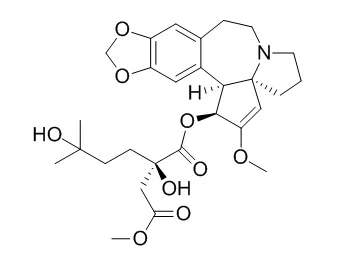| In vitro: |
| Cancer Lett. 1998 May 15;127(1-2):113-21. | | Intracellular calcium distribution in apoptosis of HL-60 cells induced by harringtonine: intranuclear accumulation and regionalization.[Pubmed: 9619866] | Harringtonine (HT), an anticancer drug with high chemotherapeutic efficiency to human chronic granulocytic/myelomonocytic leukemia, has been reported to rapidly induce apoptosis in HL-60 cells in a wide scope/range of dosage by investigators from our lab and others.
METHODS AND RESULTS:
In the present studies, by using video enhancement contrast (VEC) microscopy, we dynamically analyzed changes in intracellular calcium distribution in a single HL-60 cell over the period from the initiation of apoptosis to the obvious appearance of chromatin condensation. The results from this paper demonstrated the striking distinction of intracellular calcium distribution at different time points after treatment with HT. Before treatment in normal HL-60 cells the highest [Ca2+]i accumulation was observed in the peri-nuclear area and the lowest was observed in the nucleus; after treatment with 1 microg/ml HT for 30 min intracellular calcium diffused all over the cell compartments, while intranuclear calcium increased comparatively and significantly. The phenomenon of intranuclear calcium accumulation was further confirmed by using laser scanning confocal microscopy (LSCM). In addition, co-localization of the highest calcium region with condensed chromatin in apoptotic HL-60 cells was also observed by LSCM.
CONCLUSIONS:
Our results suggest that two sequential alterations of intracellular calcium distribution occurred in apoptotic HL-60 cells induced by HT, i.e. (a) accumulation of calcium in the nucleus and (b) regionalization in a specific nuclear region. | | Antimicrob. Agents Chemother., 2013, 57(1): 155-67. | | Inhibition of Chikungunya Virus Replication by Harringtonine, a Novel Antiviral That Suppresses Viral Protein Expression[Reference: WebLink] | Chikungunya virus (CHIKV) is a mosquito-transmitted virus that has reemerged as a significant public health threat in the last decade.
METHODS AND RESULTS:
Harringtonine, a cephalotaxine alkaloid, displayed potent inhibition of CHIKV infection (50% effective concentration [EC50] = 0.24 μM) with minimal cytotoxicity and was selected for elucidation of its antiviral mechanism. Time-of-addition studies, cotreatment assays, and direct transfection of viral genomic RNA indicated that Harringtonine inhibited an early stage of the CHIKV replication cycle which occurred after viral entry into cells. In addition, quantitative reverse transcription-PCR (qRT-PCR) and Western blot analyses indicated that Harringtonine affects CHIKV RNA production as well as viral protein expression.
CONCLUSIONS:
Treatment of Harringtonine against Sindbis virus, a related alphavirus, suggested that Harringtonine could inhibit other alphaviruses. This study suggests for the first time that Harringtonine exerts its antiviral effects by inhibiting CHIKV viral protein synthesis. |
|






 Cell. 2018 Jan 11;172(1-2):249-261.e12. doi: 10.1016/j.cell.2017.12.019.IF=36.216(2019)
Cell. 2018 Jan 11;172(1-2):249-261.e12. doi: 10.1016/j.cell.2017.12.019.IF=36.216(2019) Cell Metab. 2020 Mar 3;31(3):534-548.e5. doi: 10.1016/j.cmet.2020.01.002.IF=22.415(2019)
Cell Metab. 2020 Mar 3;31(3):534-548.e5. doi: 10.1016/j.cmet.2020.01.002.IF=22.415(2019) Mol Cell. 2017 Nov 16;68(4):673-685.e6. doi: 10.1016/j.molcel.2017.10.022.IF=14.548(2019)
Mol Cell. 2017 Nov 16;68(4):673-685.e6. doi: 10.1016/j.molcel.2017.10.022.IF=14.548(2019)